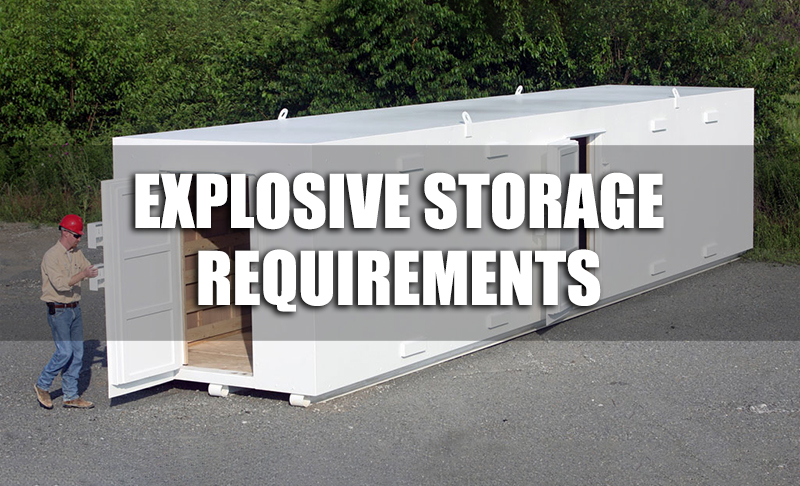Explosive Storage Requirements
Quote from admin on April 13, 2022, 10:21 am
Storage Requirements
The Federal explosives regulations at 27 CFR, Part 555, Subpart K, provide specific construction requirements for explosives magazines. This webpage is intended to provide additional information that may be useful to Federal explosives licensee and permittees. All explosive materials must be kept in locked magazines meeting the standards in Subpart K unless they are:
- In the process of manufacture;
- Being physically handled in the operating process of a licensee or user;
- Being used; or
- Being transported to a place of storage or use by licensee or permittee or by a person who has lawfully acquired explosive materials under Sec. 555. 106.
When none of the above conditions apply, explosive materials must be kept in magazines that meet the construction, locking, and table of distance requirements of Subpart K.
- Explosive materials must be stored in appropriate magazines.
- Magazines must meet all construction and housekeeping requirements of 27 CFR 555, Subpart K.
- Magazines must meet Table of Distance requirements.
- Magazines must be inspected every 7 days.
- Permanent outdoor magazines must have a substantial foundation or be metal skirted to prevent access underneath the magazine.
- Explosive materials may not be left unattended in Type-3 magazines, including "day boxes," and must be removed to type 1 or 2 magazines for unattended storage.
- Storage regulations DO NOT apply to binary explosives until mixed.
Explosive Types and Storage
High Explosives
High explosives, upon initiation, function by detonation, a rapid decomposition (explosion) of the material caused by a shock wave moving through the product at a rate faster than the speed of sound. High explosives, such as blasting caps, detonating cord, dynamite, shaped charges, boosters, etc., must be stored in:
- Type-1 permanent magazines;
- Type-2 mobile and portable indoor/outdoor magazines; or
- Type-3 magazines for attended storage.
Low Explosives
Low explosives deflagrate producing a large volume of heated gas. Low explosives, such as black powder, most display fireworks, safety fuse, igniters, igniter cord, fuse lighters, etc., must be stored in:
- Type-1, -2, or -4 permanent, portable or mobile indoor/outdoor magazines.
Blasting Agents
Blasting agents are a material or mixture consisting of fuel and oxidizer that is intended for blasting and that cannot be detonated by a No. 8 test blasting cap when unconfined. Blasting agents may be stored in:
- Type-5 permanent, portable, or mobile outdoor/indoor magazines (minimum requirement).
- Blasting Agents stored with high explosives must be stored in a Type-1 or -2 magazine.
Source: https://www.atf.gov/explosives/explosive-storage-requirements
Storage Requirements
The Federal explosives regulations at 27 CFR, Part 555, Subpart K, provide specific construction requirements for explosives magazines. This webpage is intended to provide additional information that may be useful to Federal explosives licensee and permittees. All explosive materials must be kept in locked magazines meeting the standards in Subpart K unless they are:
- In the process of manufacture;
- Being physically handled in the operating process of a licensee or user;
- Being used; or
- Being transported to a place of storage or use by licensee or permittee or by a person who has lawfully acquired explosive materials under Sec. 555. 106.
When none of the above conditions apply, explosive materials must be kept in magazines that meet the construction, locking, and table of distance requirements of Subpart K.
- Explosive materials must be stored in appropriate magazines.
- Magazines must meet all construction and housekeeping requirements of 27 CFR 555, Subpart K.
- Magazines must meet Table of Distance requirements.
- Magazines must be inspected every 7 days.
- Permanent outdoor magazines must have a substantial foundation or be metal skirted to prevent access underneath the magazine.
- Explosive materials may not be left unattended in Type-3 magazines, including "day boxes," and must be removed to type 1 or 2 magazines for unattended storage.
- Storage regulations DO NOT apply to binary explosives until mixed.
Explosive Types and Storage
High Explosives
High explosives, upon initiation, function by detonation, a rapid decomposition (explosion) of the material caused by a shock wave moving through the product at a rate faster than the speed of sound. High explosives, such as blasting caps, detonating cord, dynamite, shaped charges, boosters, etc., must be stored in:
- Type-1 permanent magazines;
- Type-2 mobile and portable indoor/outdoor magazines; or
- Type-3 magazines for attended storage.
Low Explosives
Low explosives deflagrate producing a large volume of heated gas. Low explosives, such as black powder, most display fireworks, safety fuse, igniters, igniter cord, fuse lighters, etc., must be stored in:
- Type-1, -2, or -4 permanent, portable or mobile indoor/outdoor magazines.
Blasting Agents
Blasting agents are a material or mixture consisting of fuel and oxidizer that is intended for blasting and that cannot be detonated by a No. 8 test blasting cap when unconfined. Blasting agents may be stored in:
- Type-5 permanent, portable, or mobile outdoor/indoor magazines (minimum requirement).
- Blasting Agents stored with high explosives must be stored in a Type-1 or -2 magazine.
Source: https://www.atf.gov/explosives/explosive-storage-requirements



